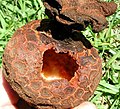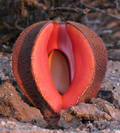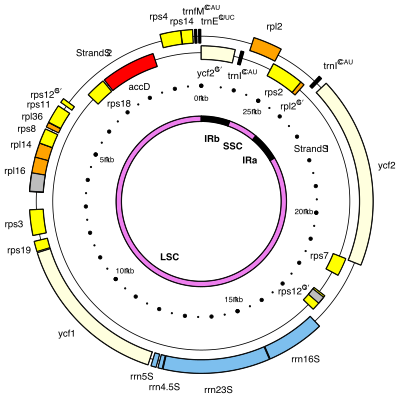
The plastid is a membrane-bound organelle found in the cells of plants, algae, and some other eukaryotic organisms. They are considered to be intracellular endosymbiotic cyanobacteria. Examples include chloroplasts, chromoplasts, and leucoplasts.

The Aristolochiaceae are a family, the birthwort family, of flowering plants with seven genera and about 400 known species belonging to the order Piperales. The type genus is Aristolochia L.
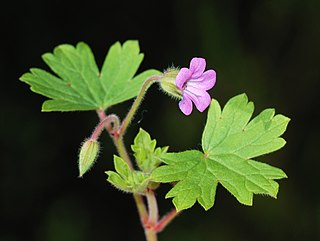
Geraniaceae is a family of flowering plants placed in the order Geraniales. The family name is derived from the genus Geranium. The family includes both the genus Geranium and the garden plants called geraniums, which modern botany classifies as genus Pelargonium, along with other related genera.

The Clusiaceae or GuttiferaeJuss. (1789) are a family of plants including 13 genera and ca 750 species. Several former members of Clusiacae are now placed in Calophyllaceae and Hypericaceae. They are mostly trees and shrubs, with milky sap and fruits or capsules for seeds. The family is primarily tropical. More so than many plant families, it shows large variation in plant morphology. According to the APG III, this family belongs to the order Malpighiales.

Iridaceae is a family of plants in order Asparagales, taking its name from the irises. It has a nearly global distribution, with 69 accepted genera with a total of c. 2500 species. It includes a number of economically important cultivated plants, such as species of Freesia, Gladiolus, and Crocus, as well as the crop saffron.

Elaioplasts are one of the three possible forms of leucoplasts, sometimes broadly referred to as such. The main function of elaioplasts are synthesis and storage of fatty acids, terpenes, and other lipids, and they can be found in the embryonic leaves of oilseeds, citrus fruits, as well as the anthers of many flowering plants.

Orobanchaceae, the broomrapes, is a family of mostly parasitic plants of the order Lamiales, with about 90 genera and more than 2000 species. Many of these genera were formerly included in the family Scrophulariaceae sensu lato. With its new circumscription, Orobanchaceae forms a distinct, monophyletic family. From a phylogenetic perspective, it is defined as the largest crown clade containing Orobanche major and relatives, but neither Paulownia tomentosa nor Phryma leptostachya nor Mazus japonicus.
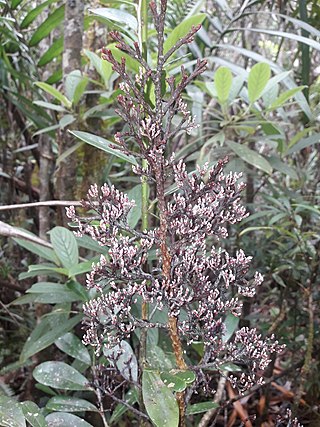
Parasitaxus usta, also known in French as cèdre rabougri, is a rare species of conifer of the family Podocarpaceae, and the sole species of the genus Parasitaxus.

Rhizanthella, commonly known as underground orchids, is a genus of flowering plants in the orchid family, Orchidaceae and is endemic to Australia. All are leafless, living underground in symbiosis with mycorrhizal fungi. The inflorescence is a head of flowers held at, or just above the ground but mostly covered by soil or leaf litter and little is known about the mechanism of pollination.

Hydnoroideae is a subfamily of parasitic flowering plants in the order Piperales. Traditionally, and as recently as the APG III system it given family rank under the name Hydnoraceae. It is now submerged in the Aristolochiaceae. It contains two genera, Hydnora and Prosopanche:

The subfamily Detarioideae is one of the subdivisions of the plant family Fabaceae (legumes). This subfamily includes many tropical trees, some of which are used for timber or have ecological importance. The subfamily consists of 84 genera, most of which are native to Africa and Asia. Pride of Burma and tamarind are two of the most notable species in Detarioideae. It has the following clade-based definition:
The most inclusive crown clade containing Goniorrhachis marginataTaub. and Aphanocalyx cynometroidesOliv., but not Cercis canadensisL., Duparquetia orchidaceaBaill., or Bobgunnia fistuloides(Harms) J. H. Kirkbr. & Wiersema.
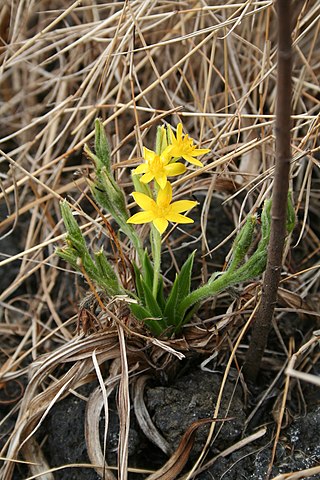
Hypoxis is a genus of flowering plants of the family Hypoxidaceae. The genus has an "almost cosmopolitan" distribution, occurring in Africa, the Americas, Asia, and Australia. Europe lacks native species. Most species are in the Southern Hemisphere, especially in southern Africa. Common names for the genus include star-grass, star lily, yellow stars, African potato, and stars. The genus is the largest of the Hypoxidaceae and has its centre of variation in South Africa, where it occurs in open undisturbed grasslands. The name Hypoxis was taken over by Linnaeus in 1759 from a name coined by Paul Reneaulme in 1611 for a superficially similar species of Gagea and meaning "a little sour", referring to the taste of that plant's leaves.

Hydnora africana is an achlorophyllous plant in the subfamily Hydnoroideae, native to southern Africa that is parasitic on the roots of members of the family Euphorbiaceae. It is also called jakkalskos or jackal food. The specific epithet africana means to be from Africa. Molecular data has suggested that Hydnoroideae is a "basal angiosperm" solidifying its place among the more primitive flowering plants. Hydnoraceae are the only angiosperms known to have no leaves or scales and are considered obligate parasites, completely dependent on their hosts to survive. The plant grows underground, except for a fleshy flower that emerges above ground and emits an odour of faeces to attract its natural pollinators, dung beetles and carrion beetles. The vegetative body of the plants has been reduced to only consisting of roots and flowers. The flowers act as temporary traps, retaining the beetles that enter long enough for them to pick up pollen.

Cynomorium is a genus of parasitic perennial flowering plants in the family Cynomoriaceae. The genus consists of only one species, Cynomorium coccineum. Its placement in the Saxifragales was resolved in 2016 with the help of nuclear, plastid, and mitochondrial sequences obtained from next-generation sequencing. Common names include the misleading Maltese fungus or Maltese mushroom; also desert thumb, red thumb, tarthuth (Bedouin) and suoyang (Chinese). A rare or local species, it grows in dry, rocky or sandy soils, often in salt marshes or other saline habitats close to the coast. It has had a wide variety of uses in European, Arabian and Chinese herbal medicine.

Hydnora triceps is a holoparasitic flowering plant native to Africa that grows on the roots of Euphorbia dregeana. Completely lacking in chlorophyll, it depends on its host for water and nutrients. The plant structure is composed of only specialized stems, buds, and haustoria, lacking any leaf-like structures entirely. It spends its life underground and only emerges to flower.

Vicoa is a genus of flowering plants belonging to elecampane tribe within the Asteraceae. It is found in parts of Africa and stretching across Asia to Indochina. It was described by Alexandre Henri Gabriel de Cassini (Cass.) in 1829, but the genus was later absorbed into the Pentanema genus. Until molecular analysis in 2018, determined it was a separate genus.
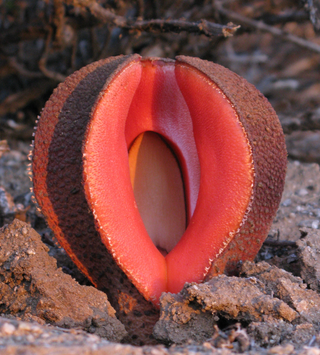
Hydnora visseri, the Visser's hydnora, is a subterranean holoparasitic plant, lacking leaves and roots, and is described from southwestern Namibia and northwestern South Africa and has the longest tepal lobes of all Hydnora species. The genus Hydnora is composed entirely of holoparasitic plants that attach to the root of their hosts and are restricted to Africa and southwestern Asia.

Daniel Lee Nickrent is an American botanist, working in plant evolutionary biology, including the subdisciplines of genomics, phylogenetics, systematics, population genetics, and taxonomy. A major focus has been parasitic flowering plants, particularly of the sandalwood order (Santalales). His interest in photographic documentation and photographic databases has led to several photographic databases including Parasitic Plant Connection, Phytoimages, Plant Checklist for the Rocky Mountain National Park, and Plant Checklist for the Crab Orchard National Wildlife Refuge.
The anthophytes are a grouping of plant taxa bearing flower-like reproductive structures. They were formerly thought to be a clade comprising plants bearing flower-like structures. The group contained the angiosperms - the extant flowering plants, such as roses and grasses - as well as the Gnetales and the extinct Bennettitales.




